
 Data Evolution:
Data Evolution:|
|
In 1984, Kodansha published a set of three pocket books devoted to the Mobile Suit Variation series, which were released as part of the Kodansha Pocket Hyakka Series. Long out of print, these books have recently been reissued. In addition to profiles of the various MSV machines, these books also included detailed features on mobile suit development history and the progress of the war between the Earth Federation and the Principality of Zeon. Mobile Suit Variation 2: Zeon Forces MS · MA Edition was published in April 1984 and included the second installment of a continuing feature on the history of the "Zeon War of Independence." This installment provided a detailed description of the Zeon invasion of Earth, the details of which are repeated almost unchanged in current accounts. I've also translated the "Principality of Zeon Military Register" section, which provides biographies of several Zeon ace pilots, as well as the mobile suit and mobile armor development history sections. The following text is copyright © 1984 Kodansha. |
| Composition: | Masahiro Oda Shuichi Ishikawa |
| Mechanical Design: | Kunio Okawara |
Translator's Note: This section is not yet translated.
Translator's Note: This section is not yet translated.
Translator's Note: This section is not yet translated.
Translator's Note: The mobile suit development history section is broken up into two parts in the original book, and I've reproduced that structure here. Although the mobile armor development history is listed as a separate section in the index, I've grouped it together with the mobile suit section under a single heading.
It was initially thought that converting the space combat mobile suit MS-06F Zaku II would be sufficient for a land warfare mobile suit. But the F type Zaku II, which weighed as much as 75 tons, was unable to function as expected on Earth. Moreover, the terrain and atmospheric conditions on Earth were not stabilized as they were inside a colony. Thus, for their initial adaptation plan, the Zeon forces developed the lightweight land warfare mobile suit MS-06J by removing space combat equipment from the F type which was unnecessary on the ground. The J type was completed just before the first landing operation and was sent to Earth as a test, but its genuine introduction to the front lines began with the second landing operation. Of course, the development of other land warfare mobile suits was also in progress elsewhere.
Due to the short time between the decision to launch an Earth invasion operation and the start of the operation itself, there wasn't time to deploy the new land warfare mobile suit MS-07 Gouf in the first or second landing operations, but its deployment began with the third landing operation.
The MS-07 Gouf was developed purely as a land warfare mobile suit, but as local conflicts continued it became clear that it couldn't always be adapted to battlefield conditions since it had only fixed armament. Thus the next to appear were the Gouf variations known as the C series. With their many fixed armament variations, each battlefield could be supplied with a version appropriate for the situation.
A serious problem remained with the deployment of both the Zaku and the Gouf under gravity. Mobile suits normally moved by walking or through the use of tanks. However, deployment using these methods proved too slow. There were plans to combine the Gouf with the Dodai YS, or to give the Gouf itself flight capabilities, but this problem was not finally resolved until the completion of the MS-09 Dom. The deployment of Dom units began only in the last stages of the war.
Land Warfare Mobile Suit Development Flow
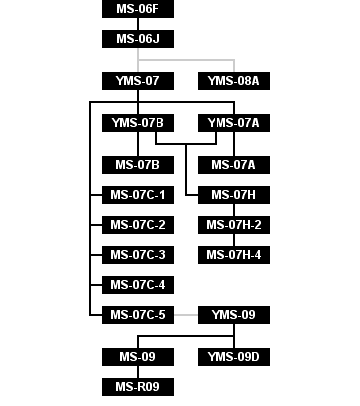
Unlike land warfare mobile suits, the MS-06 Zaku II remained the main space combat mobile suit for a long time. However, there were several variations such as the C, F, S, R-1, and R-1A types.
As the war entered its middle stages, the Federation Forces built up their fighting strength and intelligence emerged regarding the RX mobile suits, so the Zeon forces decided to develop next-generation space combat mobile suits as well. The plans presented to the military at this point were the R-2 type, a new model of the Zaku II; the R09, a space combat version of the Dom; and the newly designed MS-15 and MS-11 (later the MS-14). It appears that the MS-14 Gelgoog was the favored one, but since this project was just beginning, it was probably necessary to have other plans as emergency stopgaps.
As the development of the MS-14 Gelgoog reached its final stages, mobile suit production facilities everywhere were converted to the MS-14. Production of the Gelgoog pre-production type began in October of U.C.0079, but the beam weapon production lines only went into action in late November of that year. At this point it seems the Zeon forces still intended to introduce the Gelgoog into ground combat, since its arms were equipped with jet engines as auxiliary thrusters.
Two kinds of backpack with different functional purposes were prepared for the MS-14 Gelgoog, whose combat deployment began roughly one month before the end of the war. The ability to change backpacks according to the operation was meant to provide greater versatility. The MS-06 Zaku II also used this concept of swapping equipment, but it was not as simple as in the Gelgoog, and consisted of either minor changes to the machine itself or a simple change of armament.
The final mobile suit to appear was the MSN-02 Zeong, which was equipped with a wired psycommu system and could be called the ultimate mobile suit. It incorporated all the previous mobile suit technology of the Zeon forces (1).
The previously proposed psycommu system was first installed in a mobile suit with the MS-06Z. After this came the MSN-01, and finally a combat type was completed in the form of the MSN-02 Zeong. However, because the installation of a psycommu system required a great deal of space, these machines became very large. Also, because they were made to suit the characteristics of the individual pilots, they were unsuitable for mass production. And because it was necessary for the pilots to be Newtypes, these machines could never be main mobile suits.
Space Combat Mobile Suit Development Flow
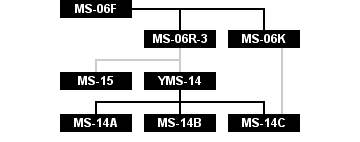
(1) I moved this passage down a couple of paragraphs so that the discussion of the Gelgoog wouldn't be interrupted by a digression about the Zeong.
Amphibious mobile suits entered development while the decision for an Earth invasion operation was still pending. The initial idea of the Zeon forces was to develop an amphibious type as a variation of the MS-06 Zaku II. This plan was realized in the form of the MS-06M Zaku Marine Type, but it proved utterly unsuitable for real combat.
The development of amphibious mobile suits then continued from a completely new perspective, and they were given MSM numbers. The MS-06M was renamed the MSM-01 and used to gather data for new models of amphibious mobile suit.
When the initial data had been gathered, the first stage of development began, producing the MSM-03 Gogg. Neither the Gogg, nor the MSM-04 Acguy and MSM-07 Z'Gok developed in the second stage, were subject to unreasonable performance demands, and they were completed in a normal fashion.
When it came to the combat deployment of these amphibious types, units were organized with a single type of machine whenever possible, making them easier to supply with resources than the ground mobile suit forces.
It was the formation of the submarine fleets that made it possible to use amphibious mobile suits effectively. At first, the Zeon forces who invaded the Earth used their submarines in a traditional fashion, conducting independent operations to destroy enemy supply lines. For better or for worse, the idea of combining submarines with amphibious mobile suits was born of the failed development of the MSM-01.
Although amphibious mobile suits were developed to perform landing operations with independent teams, when the shortcomings of the MSM-01 became clear, it was decided to support them with other weapons. Thus the combination of submarines and amphibious mobile suits was perfected, making it possible to produce tremendous combat results. Had both weapons been used independently, as per the original plan, they would have ended up being relatively ineffective.
Six submarine fleets of various sizes were organized. However, it appears that their numbers varied over time, because the vessels themselves were frequently moved or reorganized for special purposes.
Since the Zeon forces that landed on Earth had few vessels, they modified captured Federation Forces vessels for their own use.
The amphibious mobile suit development process gave birth to special operations mobile suits for use in the invasion of Jaburo.
Because Jaburo was an underground base, ordinary attacks were ineffective, and in the early stages of the war even Operation British had failed to attack Jaburo directly with a colony. Thus a plan was devised to invade Jaburo from multiple directions simultaneously, using teams made up of several machine types with distinct roles.
In this operation, the Acg would dig the invasion routes, and then the Juacg would perform medium-range attacks. The Agguguy and Zogok would provide support by entering Jaburo and engaging in melee combat. Even within the military, there were doubts as to this bizarre operation's chances of success, but ultimately they never had a chance to put it into effect.
The mobile suit amply demonstrated its abilities as a general-purpose weapon in the recent war, but, as local warfare became more diverse, situations arose to which it could not adapt. Aside from creating more mobile suit variations, the development of support weapons was also proposed as a solution.
These planned weapons were called mobile armors. As movable support weapons with an emphasis on offensive power, they had far heavier armor and armament than mobile suits. The starting point for mobile armor development was the space pod enhancement plan proposed in the first stage of the mobile suit project.
Their combat introduction, which also served as field testing, began in the last stages of the war, and combat units were also organized. However, because this was just before the end of the war, they were unable to produce significant results.
The psycommu system was a control system created primarily for Newtype pilots to operate mobile suits. However, it was not compact enough to be installed in a mobile suit of normal size, and it was introduced in mobile armors instead.
One distinguishing characteristic of this system was that it made remote control possible despite the effects of Minovsky particles. If weapons could be controlled remotely, there was no need for the machine itself to be humanoid, so it was inevitable that mobile armors equipped with psycommu systems were introduced into combat earlier than mobile suits.
Incidentally, the MAN-03 and MSN-08 were the only two types of mobile armor equipped with psycommu systems.
Translator's Note: The following account is continued from Mobile Suit Variation 1: Zaku Edition and concludes in Mobile Suit Variation 3: Federation Forces Edition.
After the Battle of Loum, the Principality of Zeon called on the Earth Federation to surrender. At the time there were many within the Federation who said that, after the loss of roughly half the total population and more than a quarter of their fighting strength, they had no choice but to surrender before Zeon's military might. Thus both nations came to the table for a peace conference in Antarctica. But while the conference was in progress, General Revil, who had made a miraculous escape from the Principality of Zeon, gave his speech "No Soldiers in Zeon." This raised the Federation's morale, and the peace conference became a discussion of a wartime treaty.
The Antarctic Treaty concluded here prohibited the use of nuclear, biological, and chemical weapons, the mistreatment of prisoners, direct attacks on colonies, and aggression towards the resource transportation lines from Jupiter.
Zeon's national resources at this point were considerably weaker than the Federation estimated. However, both sides had sustained heavy losses in the fighting during the outbreak of war. Their fighting strength in space reached a low-level balance, turning the war into a stalemate.
Having been unable to secure victory in the previous conference, the Zeon forces decided to carry out a direct attack on Earth. Securing military resources was also a factor in this decision.
The creation of the Earth Attack Force was accomplished by reorganizing and reinforcing the 1st Mobile Infantry Division of Rear Admiral Kycilia Zabi's Armored Assault Force. Captain Garma Zabi was appointed as its commander. However, this force had not yet recovered from the losses of the Battle of Loum, and it was inadequate in terms of fighting strength.
Of the units incorporated into the Earth Attack Force, many were made up of people from other Sides who had secretly entered Zeon just before the outbreak of war. The majority of them had been forced by the Federation government to emigrate to the colonies, and were thus strongly hostile towards the Federation. Before the war, the Principality of Zeon began contacting these people either directly or via Side 6, and arranged for them to escape to the Principality.
Areas Damaged by Operation British
Black indicates areas of total destruction. Gray indicates areas of major damage.
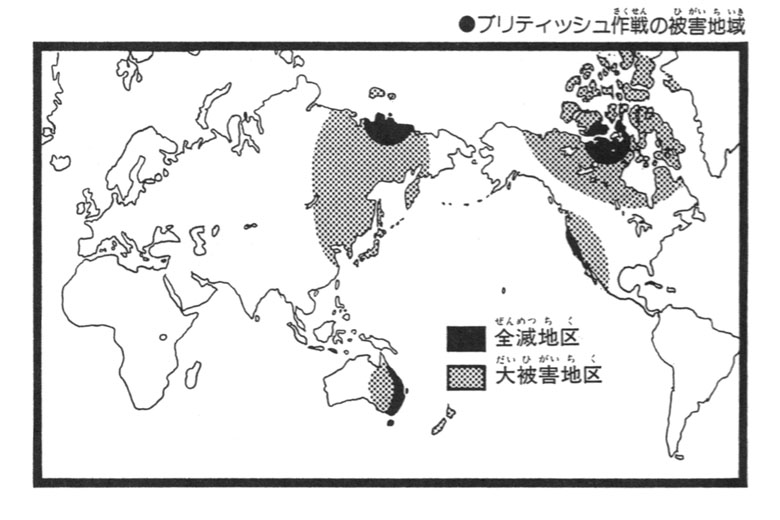
The Zeon forces carried out their first Earth invasion operation on March 1, U.C.0079, in the third month after the outbreak of war. The landing force consisted of the 1st Terrestrial Mobile Division of the Earth Attack Force. The landing points were the Aral Sea and Lake Balkhash, located to the north of the Tien Shan mountain range in central Asia, and the attack targets were the Federation Forces and the Baikonur space base.
Mobile suits served as the backbone of the first landing force, with the majority being the MS-06F Zaku II. Although some vehicles and infantry accompanied them, their fighting strength didn't amount to much.
After the target had been captured, this space base was used to begin the work of landing tanks and aircraft on the ground. The combat units then divided into two groups, with one heading from the northern shore of the Caspian Sea into Europe, while the other headed south along the eastern shore of the Caspian Sea into the Middle East.
Incidentally, of the mobile suits that landed at this point, most of the MS-06 Zaku II units were upgraded to the J type during subsequent overhauls.
In the second and largest of the landing operations, the 2nd and 3rd Terrestrial Mobile Divisions landed along with part of the air and naval forces, as well as the Earth Attack Force headquarters.
The landing points were the east and west coasts of North America, and the operation objectives were to capture military and industrial facilities and secure food supplies. One particularly important military facility was the California Base, which was taken almost undamaged and played an important role in the subsequent Earth invasion.
During these landings, there were essentially no counterattacks from the Federation Forces. This was because the greater part of the Federation Forces had been dispatched to areas damaged in Operation British and were engaged in recovery work. It could be said that the strategy of the Zeon forces was to choose regions where Operation British had created a military vacuum as their landing points.
The second landing operation was conducted on March 11, and the third landing operation began one week later, on March 18. The 4th Terrestrial Mobile Division landed along with many support units, but the operation was aimed more at securing resources than military objectives.
Of the mobile suits that landed on Earth, the F type Zaku II made up the majority in the first landing operation, and the J type in the second and third. The MS-07 also began participating as of the third operation, but the numbers of the Zaku II were overwhelmingly higher.
The reserve forces were a so-called "foreign legion" of people who had entered Zeon before the outbreak of war. Having enlisted around the time of the One Week Battle, they were assigned to combat units just before landing.
Most of the members of this foreign legion descended to the Red Sea and the coast of the Persian Gulf during the second landing operation, and without exception they were sent into Earth's most fiercely contested areas. Officially, this was because they were superb soldiers with strong anti-Earth Federation sentiments who would fight to the last man. But in fact, it is believed that Supreme Commander Gihren Zabi made a political judgement that this foreign legion could be readily discarded, and accountability for its actions easily avoided, during any postwar reckoning.
The division commanded by Captain M'Quve was responsible for mining mineral resources and transporting them to the homeland. It landed on the northern shore of the Caspian Sea on March 4, U.C.0079, capturing mining facilities in every area and taking charge of their operation. This division was made up mainly of engineering and technical units, and had few combat units.
This corps also reported directly to Rear Admiral Kycilia and wasn't included in the Earth Attack Force command structure. The fact that there were two separate chains of command on Earth was a grave mistake by the Zeon forces, and was to have a major effect on the later war situation.
Earth Attack Force Landing Points
Labels indicate landing points of M'Quve corps and reserve forces, first landing point, second landing points A and B, third landing points A, B, and C.
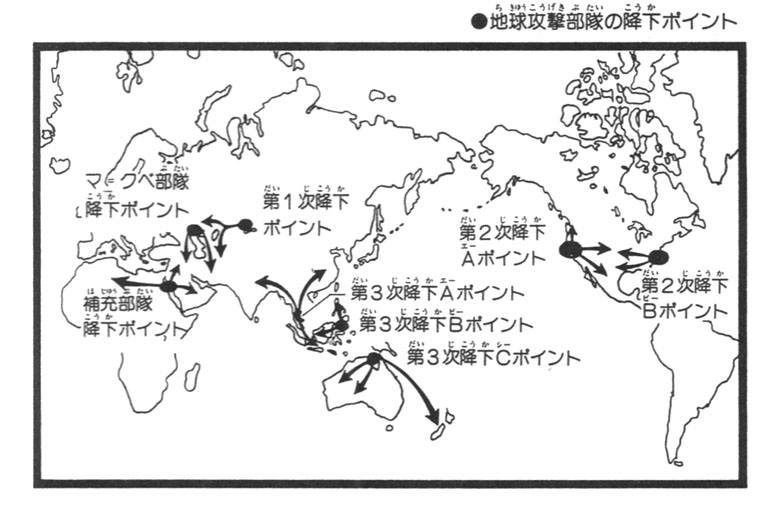
Regions Occupied by the Zeon Forces
Black indicates regions occupied by Zeon forces. Gray indicates main combat areas.
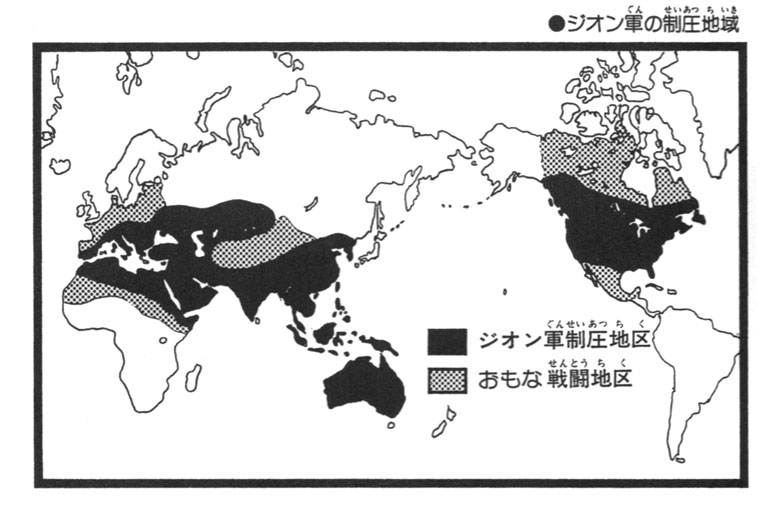
The greatest achievement of the series of Earth landing operations conducted by the Zeon forces was the capture of the California Base on the west coast of North America. This California Base wasn't a single base, but rather a general term for a total of at least twenty military facilities, including naval ports, air bases, spaceports, and various kinds of weapons research, development, and testing facilities. The facilities in the coastal areas had been annihilated due to Operation British, but those further inland were undamaged, and most of the Federation Forces defense units had been dispatched to perform recovery work in damaged areas. The Zeon forces' mobile suits took advantage of this opportunity to attack, and the base fell into the hands of the Earth Attack Force virtually intact. Its various facilities were repaired within about two weeks of its capture, and it began to function as the largest base of the Earth Attack Force. It served as a center for everything from the development and production of various kinds of weapons, starting with mobile suits, to the collection and delivery of resources for all regions of the world.
During the last stage of the war, the Earth Attack Force chain of command was temporarily disrupted by the death of Captain Garma Zabi. Taking advantage of this opportunity, the Federation Forces immediately launched an offensive against the California Base and recaptured it. The Federation Forces held onto this base from then on, and it served as an arsenal second only to Jaburo.
Main Bases of the Zeon Forces
From left to right, labeled bases are Alexandria, Suez, Katarl, Baikonur, Brunei, Subic, Hawaii, California, Mayport, Cape Canaveral, and Norfolk.
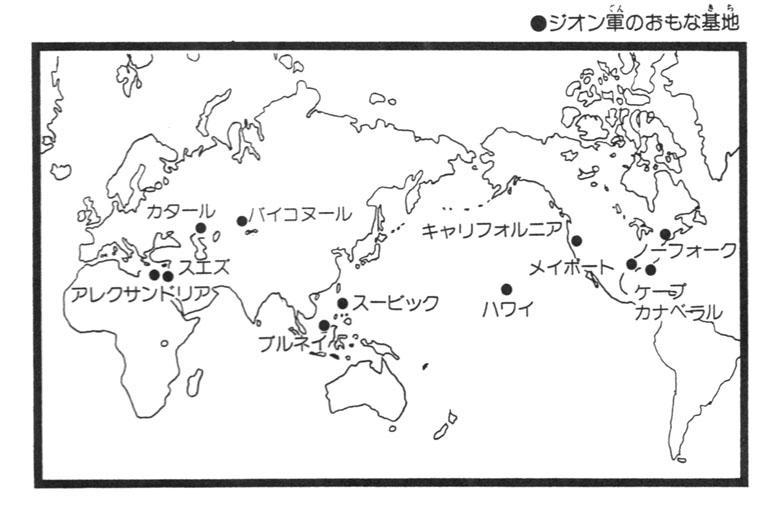
Translator's Note: In most cases, I've spelled these character names as they appear in the index of the Gundam Officials encyclopedia. The only exceptions are "Eliot Lem" and "Alfredeano Ram" which I changed to the more common "Elliot" and "Alfredino," and "Thomas Cruz," which I changed to "Tomas" to match the markings of the Gelgoog shown on the cover of this volume. All ranks are translated as their naval, rather than army, equivalents.
Register Number / PM056330279A
Assignment / Armored Assault Force
Personal History / Born in U.C.0056. A third-generation descendant of early Side 3 colonists who emigrated from the Australian continent, and one of the few people in Zeon with an American heritage. Upon concluding his higher education at age 22, he volunteered for the national defense forces. After graduating from military academy he was assigned to the Armored Assault Force as a mobile suit pilot.
During the One Week Battle, he entered the battlefield as a Chief Petty Officer and piloted an MS-06C Zaku II. Due to his accomplishments in the Battle of Loum, where he sunk three battleships, he was promoted to the rank of Lieutenant and received an MS-06F Zaku II. From this point on, his mobile suits had a crimson body color with black accents, and for this reason they were often confused with those of Lieutenant Commander Char. Ridden was subsequently promoted to a Lieutenant Commander and received an MS-06R-2 Zaku II.
In January of U.C.0080, he was assigned to the Ace Corps on orders from the homeland, and began piloting an MS-14B. After familiarization exercises in the Corregidor shoal zone, Lieutenant Commander Ridden became the commander of the 1st Company of the Ace Corps. He participated in the fierce fighting at the Battle of A Baoa Qu, but his subsequent fate is unknown.
On January 25 of U.C.0080 he was classified as missing in action, given a final promotion to the rank of Commander, and removed from the military register.
Register Number / PM055767441S
Assignment / Space Strike Fleet
Personal History / Born in U.C.0055 at Side 3. The eldest son of the Matsunaga family, a family equal in distinction to the Federation's Yashima family and whose name reflects its Oriental heritage. He was the only member of his family to join the military.
He enlisted in the military just before the outbreak of war and entered combat as a Seaman First Class, piloting an MS-06C Zaku II in normal colors. Due to his exploits at the Battle of Loum, he subsequently received an MS-06F Zaku II in white colors which bore his personal emblem. During this battle he received a battlefield commission due to the death of his direct superior. Thanks to his achievements since the outbreak of the war, which included the destruction of one battleship and five cruisers, he also received a special two-rank promotion to Lieutenant Junior Grade.
His abilities as a pilot caught the attention of Vice Admiral Dozle, and he served as an escort whenever Dozle entered combat airspace in his personal custom Zaku to perform a battlefield inspection.
Matsunaga was now a Lieutenant Junior Grade, but because he had become an officer through a battlefield commission, he had to attend military academy in accordance with regulations. No sooner had he graduated and performed his first formal sortie than he was promoted to a full Lieutenant. It was at this point that he received the MS-06R-1A Zaku II for which he is now best known.
Because he had been recalled to the homeland of Side 3, he did not participate in the Battle of Solomon and thus escaped death in battle, but his mobile suit remained behind and was destroyed by fire. He then remained at Side 3 until the end of the war.
Register Number / MT029668322Z
Assignment / Zeonic Company Development Department (civilian)
Personal History / Born in U.C.0039 at Side 1. He graduated from an Earth Federation comprehensive university and graduate school with degrees in space engineering, nuclear physics, and general astronautics, as well as a license to operate small spacecraft.
Subsequently moving to Side 3, he joined the Zeonic Company and was placed in charge of designing worker machines. With the formation of the national defense force and the launch of the SUIT Project, he became part of the company's internal project team. He began working on the project as of the MS-02 and, with the development of the MS-05 and MS-06, he was transferred from the company to become a military employee with status equivalent to that of a field officer. As a member of the development staff who could also operate spacecraft, he served as a test pilot for the mobile suits he developed, and even helped write their combat manuals.
As the R-1 and R-2 models of the MS-06 Zaku II were developed, he participated in their flight testing as well. At this point he was equivalent in status to a Commander. He returned to the Zeonic Company to help develop its second-stage space combat mobile suit, and became a main member of the MS-06R-3 Zaku III development team, but he pursued his own line of research rather than paying attention to the military weapons development that was in progress at the time.
When the war ended, he was in the industrial sector of Side 3's Colony 14. Although he had hoped to stay at Side 3 after the war, he instead returned to Earth at the request of the Federation government, and became an officer of the Federation Forces technical headquarters.
Caption: A famous photograph taken on his fortieth birthday in U.C.0079. At first glance, this photograph almost suggests the image of a sportsman.
Register Number / PM045898156G
Assignment / Earth Attack Force
Personal History / Born in U.C.0045 at Side 4, and graduated from the Mua branch of a Federation comprehensive university in U.C.0067. The descendant of emigrants from the European continent, of German ethnic heritage.
He had two daughters named Amalia and Limia. After losing his wife Katie in a spacecraft accident in U.C.0078, he moved to the Principality of Zeon and enlisted in the military.
After receiving training as a mobile suit pilot, he was assigned to the First Mobile Infantry Division of the Armored Assault Force. He suffered an injury to his left eye during Operation British, but escaped being completely blinded, and returned to the front lines after the Battle of Loum.
Just after his return, his unit was reorganized, and he was assigned to the 5th Terrestrial Mobile Division of the Earth Attack Force. He descended to the Red Sea during the Second Landing Operation, and from then until the end of the war he served as the commanding officer of Team A of the 5th Terrestrial Mobile Division's 1st Mobile Suit Battalion, also known as the Caracal Corps. His rank at this point was Lieutenant Commander. His aggressive fighting made him popular with many of his soldiers. He ended the war at the Alexandria base, and his subsequent fate is unknown.
Caption: One of the few photographs of Lieutenant Commander Greenwood (formerly Grunwald). This snapshot was taken in North Africa in August of U.C.0079, prior to a sortie.
Register Number / PM0513384612G
Assignment / Earth Attack Force
Personal History / Born in U.C.0051 at Side 3. Joining the military early on, he was assigned to a rear support unit. As a soldier, he was an unusually good theoretician with a talent for looking ahead.
Around the beginning of the war he was part of a mobile suit training corps, where he taught mobile suit combat under gravity. When the unit was reorganized in March of U.C.0079, he was assigned to the 2nd Terrestrial Mobile Division of the Earth Attack Force, and participated in the capture of the California Base. He subsequently served as part of the base garrison. When the new MS-06K Zaku Cannon unit was organized, he was promoted to Lieutenant Junior Grade based on his previous accomplishments and became the unit's company commander.
In January of U.C.0080, he entered combat in the 06K (1). By the end of the war, he had destroyed 34 aircraft, 71 fighting vehicles, and two mobile suits, leading investigators to ask whether he may have had Newtype abilities. He ended the war at the Cape Canaveral base, was released in October of the following year, and returned home to the newborn Republic of Zeon.
Caption: The precise time and place of this photograph are unclear, but it was later suggested that it was taken when he was promoted to Lieutenant Junior Grade in October of U.C.0079.
Register Number / PM0571977243S
Assignment / Space Strike Fleet
Personal History / Left the Mass family of Earth in U.C.0075, and was entered in the family register of Side 3's Aznable family. He entered military academy the same year, and was a classmate of Garma Zabi. A year and a half later he graduated early due to a special wartime exemption, graduating at the head of his class.
After serving in the Mobile Training Battalion, he was assigned to the Space Strike Fleet. Due to his achievements in the One Week Battle he was promoted to Lieutenant Commander and received an MS-06S with original markings. He became known as the Red Comet due to the high-speed hit and run tactics he employed in the Battle of Loum.
In September of U.C.0079, he detected and attacked the new Federation Forces warship and mobile suits produced by the Operation V development project, but they succeeded in escaping. He was relieved of duty and removed from the military register after Captain Garma Zabi, supreme commander of the Earth Attack Force, was killed during this series of battles.
He was reinstated in the military on orders from Rear Admiral Kycilia, and assigned to the Earth Attack Force with the rank of Captain. In November of that year, he was placed in command of the Independent 300th Squadron, the Armored Assault Force's Newtype corps.
Following the battle at Texas, he entered combat at the Battle of A Baoa Qu in the Zeong. On this battlefield he confronted his longtime rival, the Federation Forces' RX-78-2, for the final time, and the two machines destroyed each other. It is unknown whether he survived the war.
At the beginning of the war, he piloted an MS-06C Zaku II. He went on to use the S type Zaku II, the MSM-07S Z'Gok, the YMS-14 Gelgoog, and the MSN-02 Zeong.
Register Number / PM0492378642A
Assignment / Armored Assault Force
Personal History / Born in U.C.0049 at Side 3. As a student, he majored in engineering. In U.C.0073 he joined the military, underwent training as a reserve pilot, and was assigned to one of the earliest mobile suit units. He received a battlefield commission to Ensign during the Battle of Loum.
After this, he became a technical officer at Granada. In January of U.C.0080, he was assigned to the Ace Corps as an MS-14C pilot. He ended the war at Side 3. Before piloting an MS-14C, he also used the MS-06F and MS-R09.
Register Number / EX0570042196G
Assignment / Earth Attack Force
Personal History / Born on Earth in U.C.0057. Formerly a member of the Federation Air Force. His family came from Side 3 and, upon the outbreak of war, he defected to the Principality of Zeon.
He was subsequently assigned to the 5th Terrestrial Mobile Division of the Earth Attack Force. Piloting an MS-06J and then an MS-07B, he distinguished himself as part of the guerilla corps G-27. He was later assigned to the Ace Corps at Granada and became an MS-14C pilot. He died in action at the Battle of A Baoa Qu.
Unit History / The Black Tri-Stars were formally designated as a special forces team attached to the headquarters of the 1st Mobile Suit Battalion of the Armored Assault Force's 7th Division.
The team's origins can be traced back to the formation of the Mobile Training Battalion in May of U.C.0076. At that point, Petty Officer A. Gaia and Chief Petty Officers Ortega and Mash were among the members of Team D of the 2nd Company. Their mobile suits were painted in dark sea blue, and they had not yet formed into a proper team.
Upon the outbreak of war in January of U.C.0079, a team of three mobile suits led by Petty Officer Gaia participated in an attack on Side 5 (2). Despite the use of the Jetstream Attack, the operation was a failure, and they returned home.
Gaia was promoted to Ensign and, starting with the Battle of Loum, he formed a team with Ortega and Mash. They piloted the MS-06C Zaku II in this battle. In recognition of their capture of General Revil, they were subsequently rewarded with an upgrade to the S type Zaku II. The black, purple, and grey team colors for which they are now well known date from the time of this reorganization. They went on to pilot the R-1A type, continually adding to their exploits.
The Black Tri-Stars became Rear Admiral Kycilia's trump card, and were accordingly well treated.
In October of U.C.0079, after land warfare training, they descended to Earth in preparation for Operation Odessa. Piloting the new heavy land warfare mobile suit MS-09 Dom, the team engaged the RX-78 in battle and was annihilated.
Assigned to the 4th Terrestrial Mobile Division of the Earth Attack Force. Final rank of Lieutenant Junior Grade. As part of a mobile suit company, produced good results in the conquest of the eastern Asia region. Piloted an MS-07B Gouf in dark brown colors, whose famous "China Lady" emblem was used by the entire unit.
Assigned to the 4th Terrestrial Mobile Division of the Earth Attack Force. Final rank of Lieutenant Junior Grade. Famous for using the "Gouf Lady" personal emblem. Earned great distinction in expanding the occupied region of Southeast Asia. Particularly excelled in anti-tank warfare, and was held in high regard even by the Federation Forces. Went missing in action during a mobile suit battle against the Federation Forces just before the end of the war.
Assigned to a combat support mobile suit company under the direct control of the Earth Attack Force's California Base. Final rank of Ensign. A member of the Zaku Cannon company commanded by Lieutenant Junior Grade Graden. Excelled in anti-ground support bombardment and demonstrated high accuracy, but was not a Newtype pilot. Ended the war in Florida and later returned to Side 3.
Assigned to the 2nd Mobile Suit Battalion of the Earth Attack Force's 5th Terrestrial Mobile Division. Final rank of Lieutenant. Born at Side 2, and went on to serve as commanding officer of the Scorpio commando unit in the western Middle East. Piloted an MS-07D with the famous "Arabian" unit emblem. After the war, emigrated to Side 7, whose development had been restarted.
(1) The "Mobile Suit in Action" feature in the previous volume indicates that the Zaku Cannon unit entered combat in October or November of the previous year. This inconsistency remains unexplained.
(2) The Japanese text seems unclear as to whether Ortega and Mash were also members of this particular team.
Mobile Suit Gundam is copyright © Sotsu • Sunrise. Everything else on this site, and all original text and pictures, are copyright Mark Simmons.